(rev. 01/06/2008)
Notes On Chapter Twelve
-- Long-Distance Digital Connection Technologies
- 12.1 Introduction
- LAN technology can't economically support very large numbers of
hosts or long-distance connections.
- This chapter is about long-distance network connections and
the technologies that connect networks to homes and businesses.
- 12.2 Digital Telephony
- Analog voice communication over long distance
is problematic. Signals fade and distort over long distances.
Repeaters can help, but they introduce more distortion.
- It's possible to deliver better audio at the receiving end if one
digitizes the audio for transmission and reconstructs the analog
from the digital after it arrives. Telephone companies have been
interested in this since long before data networks became
prevalent.
-
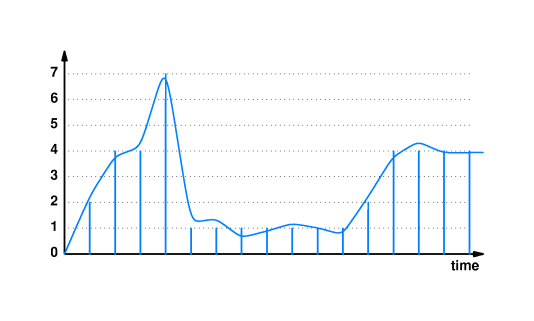 To digitize audio, we sample the analog
voltage at regular intervals and assign one of 256 discrete integral
values to the voltage.
To digitize audio, we sample the analog
voltage at regular intervals and assign one of 256 discrete integral
values to the voltage.
- We then transmit binary codes for the integers one after another
in the order that we make the measurements.
- Attenuation of the digital information is
not nearly as problematic as attenuation of analog data.
As long as the receiver is able to determine the value of each
number, there is no real loss.
- To get enough fidelity in the audible range,
the standard (Pulse Code Modulation) calls for 8000 digital samples
per second (one sample every 125 microseconds [μs]) and
digitized levels ranging from 0 to 255.
- 12.3 Synchronous Communication
- Telephone companies lease analog voice lines to people who build
data networks. The 'networkers' can use the leased lines to
transmit digital data.
- Telephone companies also have equipment for
transmitting digital information in sophisticated ways.
- The technology for digitized voice is synchronous -- the
voice data is carefully sent at a specific rate by telephone
technology -- it has to be heard coming out just as it sounded
going in -- that requires that the data come out of the system at
exactly the same rate that it entered.
- 12.4 Digital Circuits and DSU/CSUs
- People who build long-haul networks often
use leased digital voice lines as described above for
point-to-point links.
- There are radical differences in the digital standards used for
digital computer data and digital voice data.
-
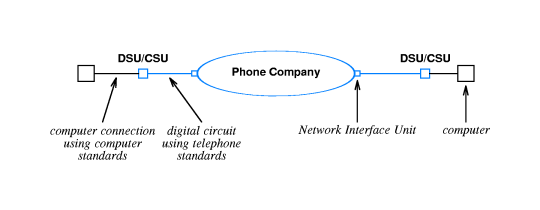 The network connections need to have a special converter called a
Data Service Unit/Channel Service Unit (DSU/CSU) installed at each
end of the line. The DSU/CSU converts
between two incompatible digital data formats.
The network connections need to have a special converter called a
Data Service Unit/Channel Service Unit (DSU/CSU) installed at each
end of the line. The DSU/CSU converts
between two incompatible digital data formats.
- 12.5 Telephone Standards
-
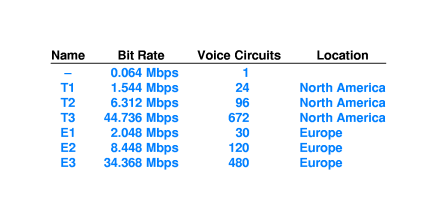 One family of digital voice lines
belonging to the telephone companies have names that begin with
T-. The T-series is a popular choice for network links,
especially the T1. The chart shows some data rates for T-series.
One family of digital voice lines
belonging to the telephone companies have names that begin with
T-. The T-series is a popular choice for network links,
especially the T1. The chart shows some data rates for T-series.
- 12.6 DS Terminology and Data Rates
- One voice channel requires 8000 8-bit samples per second. That
is 64,000 bits per second. 1.544Mps is just over 24 times
64,000. Therefore a T1 line has capacity
for 24 simultaneous voice channels plus a little overhead.
The T2 line is equivalent to 4 T1 lines -- so in
particular the telephone company can "implement" four T1 lines
with a T2 line. Similarly, a T3 line is equivalent to 28 T1
lines.
- Another family of names for these same lines: DS1, DS2, and DS3
is perhaps more proper, but the distinction is seldom made.
- The T-names stand for the carrier system
- The DS-names stand for the rules about multiplexing multiple
phone calls on the connections.
- 12.7 Lower Capacity Circuits
- T1 lines are expensive --
thousands of dollars per month. T3 costs several tens of
thousands of dollars per month.
- Telephone companies using time division multiplexing can lease
fractions of a T1 line.
- 64 Kbps is a popular fractional rate.
- 12.8 Intermediate Capacity Digital Circuits
-
 For customers that need more capacity than
T1, but less than T2 or T3, there is a technology called inverse
multiplexing.
For customers that need more capacity than
T1, but less than T2 or T3, there is a technology called inverse
multiplexing.
- Under inverse multiplexing, multiple lines, say two T1 lines, are
ganged together and operated as if they were one line with two times
the capacity of a T1 line.
- The computer on one end of the connection sends digital information
to an electronic device called an inverse multiplexor (inverse mux).
The inverse mux alternates sending parts of the data over each of
the multiple lines. An inverse-mux at the other end reassembles the
multiple data streams into one. DSU/CSU functionality is required
for the ends of each T1 line. The inverse-mux'es may do that work,
or there may be separate DSU/CSU's.
- 12.9 Highest Capacity Circuits
-
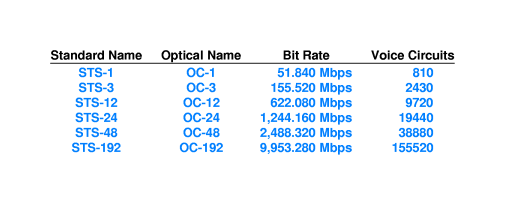 Telephone companies have Synchronous Transport Signal (STS) digital
circuits for major (trunk) communication lines. As the chart shows,
capacities of STS greatly exceed capacities of T-series digital
circuits.
Telephone companies have Synchronous Transport Signal (STS) digital
circuits for major (trunk) communication lines. As the chart shows,
capacities of STS greatly exceed capacities of T-series digital
circuits.
- It's interesting that cheap LAN's have data rates that are extremely
expensive to obtain from telephone companies.
- 12.10 Optical Carrier Standards
- The higher STS data rates require optical
fiber. The OC-X codes refer to that.
- 12.11 The C Suffix
- If the code above has a C suffix (concatenated), it means the line
is not inverse-multiplexed. For example an OC-3C is just a single
line operating at 155,520 Mbps, while an OC-3 is three OC-1 circuits
operating at 51.840 Mbps each.
- Operationally, there is not much difference but data network
designers tend to prefer the flexibility of concatenated circuits.
- 12.12 Synchronous Optical NETwork (SONET)
- The SONET standard for transmission over STS circuits is geared
to synchronized voice transmission, but data networks leasing
these lines are often required to use SONET encoding on the
circuit "to define framing and encoding."
- 12.13 The Local Subscriber Loop
- The slow analog voice connections running
from the local telephone central office to person's homes is a
bottleneck.
- Modems can't get much faster using the old
style analog circuit standards.
- There are alternatives that have become prevalent.
- 12.14 ISDN
- Integrated Services Digital Network (ISDN) is a standard for
running digital voice, data, and compressed video over the same
twisted pair phone lines used for analog voice.
- ISDN offers two B channels at 64 Kbps each plus a control D
channel at 16 Kbps.
- ISDN had some advantages at one time but
never really got into mainstream use, and nowadays the cost is not
worth the minor speed advantage it offers.
- 12.15 Asymmetric Digital Subscriber Line
Technology
- ADSL technology is quite a bit newer than ISDN. It provides very fast downstream bit rates (as much
as 6.144 Mbps) and bit rates upstream which are quite adequate for
the needs of typical Internet users (up to 576 Kbps).
- ADSL is designed to run over ordinary analog
voice lines in a frequency range where it does not interfere with
the analog telephone service. Both services can use the
line simultaneously.
-
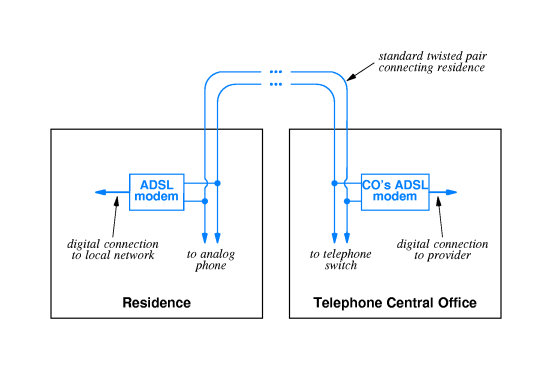 A pair of special ADSL modems have to be installed on the line, in
parallel to the existing circuit.
A pair of special ADSL modems have to be installed on the line, in
parallel to the existing circuit.
- When you run ADSL, it adapts to the unique characteristics of the
circuit. It uses a combination of frequency
division multiplexing and inverse multiplexing technologies
(Discrete Tone Modulation: DMT). ADSL finds
frequencies with high signal-to-noise ratio on the line. It
pushes more bits per second into those frequencies.
- There is no guaranteed data rate with ADSL.
ADSL does as well as the line conditions allow. Downstream
rates vary tremendously, from 32 Kbps to 6.4 Mbps, and upstream
varies from 32 to 576/640 Kbps.
- The 'original' ADSL requires that a technician install a Network
Interface Device (NID) and splitter - a filter to separate the
frequency bands used by voice and data. There is another standard
(ITU G.992.2 or 'G.lite') that does not require a splitter, but uses
microfilters inline with the ADSL modem, phones and fax machines.
G.lite is cheaper but runs slower - maybe on the order of 1.5 Mbps
downstream.
- (It would be interesting to get information on what are the averages
and variances in data rate actually experienced with these
services.)
- Since the computers of DSL users can stay up and connected to the
Internet continuously, they can be more vulnerable to hackers. It's
advisable to use a firewall.
- 12.16 Other DSL Technologies
- SDSL is symmetric. It is like ADSL, but provides equal data rates
in both directions.
- On some lines, SDSL works well but ADSL does not.
- "Reverse ADSL" is rare -- a service that is faster upstream than
downstream.
- HDSL is High-Rate Digital Subscriber Line. It provides the speed of
T1/DS1 -- 1.544 Mbps in both directions. You need two twisted pairs
and you have to be very close to the CO.
- HDSL2 is like HDSL, but requires only one twisted pair.
- HDSL technology can be used on a circuit containing a bridge tap --
some DSL technologies cannot.
- VDSL is very-high bit rate DSL: up to 52 Mbps. It requires
"intermediate concentration points" in neighborhoods, with fiber
connections the rest of the way to the CO.
- 12.17 Cable Modem Technology
- ADSL notwithstanding, telco twisted pair
wiring is vulnerable to interference and has limited bandwidth.
- TV cable is coaxial. It has very high
bandwidth and is all but immune to interference. Cable
modem technology employs a combination of frequency- and
time-division multiplexing with spare cable TV capacity to provide
computer networking.
- Since cable users share the same medium, more users means less
network capacity per user.
- Cable modem users too may be vulnerable to hackers. They also
are advised to use a firewall.
- 12.18 Upstream Communication
- Cable companies that deliver TV are well-equipped to provide
downstream digital data service, but upstream service is a different
matter. To provide upstream service, cable
companies have to revamp a lot of equipment, such as
unidirectional broadband amplifiers.
- There are some hybrid schemes that use telephone for upstream and
cable for downstream.
- The cable companies that have added upstream
capability can also provide interactive television and video on
demand (thought to be the "killer application" for home
networks).
- 12.19 Hybrid Fiber Coax
- HFC connects the cable company office via
optical fiber trunk lines to neighborhood. Ordinary coax runs
from neighborhood stations to subscribers' homes.
- HFC would improve service, but it requires the cable company to
purchase and install a lot of expensive equipment.
- 12.20 Fiber to the Curb
- Fiber trunk lines and coax plus twisted-pair to the subscriber.
- 12.21 Head-End and Tail-End Modems
- A head-end modem that follows Cable Modem Termination
System (CMTS) is located at the central office.
- The subscriber's modem is the tail-end modem, often running
the Data Over Cable System Interface Standard (DOCSIS) which
allows the subscriber to make requests and receive replies.
- 12.22 Wireless Alternatives for Special Cases
- Getting good data connections to "rural"
areas is a special challenge. DSL is problematic or
impossible in areas that are far from a telco central office or on
lines that have coils, taps, or repeaters. This is likely in rural
areas. Cable TV is unlikely to exist in rural areas.
- In such environments, one can use something like mobile phone
technology for data networking.
- There is also a broadband 155 Mbps technology called WiMAX
(Worldwide Interoperability for Microwave Access - IEEE 802.16) with
a range of about 30 miles.
- 12.23
Broadcast Satellite Systems
- A geostationary satellite system offers high bandwidth and no need
for terrestrial communication links.
- Disadvantages:
- Delay: about 1/4 second from ground to ground.
- Uplinks are large and expensive
- Low-cost satellite-based local loop systems employ:
- A broadcast mechanism - like Ethernet
- An alternative uplink path - e.g. conventional dial-up
- More recently technologies like VSAT have made
satellite uplinks possible in homes and small businesses.
- The use of low earth orbit satellite arrays is another option.
- One hopes that there will remain some way to "get away from it
all."
- 12.24 Summary
 To digitize audio, we sample the analog
voltage at regular intervals and assign one of 256 discrete integral
values to the voltage.
To digitize audio, we sample the analog
voltage at regular intervals and assign one of 256 discrete integral
values to the voltage.  The network connections need to have a special converter called a
Data Service Unit/Channel Service Unit (DSU/CSU) installed at each
end of the line. The DSU/CSU converts
between two incompatible digital data formats.
The network connections need to have a special converter called a
Data Service Unit/Channel Service Unit (DSU/CSU) installed at each
end of the line. The DSU/CSU converts
between two incompatible digital data formats.  One family of digital voice lines
belonging to the telephone companies have names that begin with
T-. The T-series is a popular choice for network links,
especially the T1. The chart shows some data rates for T-series.
One family of digital voice lines
belonging to the telephone companies have names that begin with
T-. The T-series is a popular choice for network links,
especially the T1. The chart shows some data rates for T-series.
 For customers that need more capacity than
T1, but less than T2 or T3, there is a technology called inverse
multiplexing.
For customers that need more capacity than
T1, but less than T2 or T3, there is a technology called inverse
multiplexing.  Telephone companies have Synchronous Transport Signal (STS) digital
circuits for major (trunk) communication lines. As the chart shows,
capacities of STS greatly exceed capacities of T-series digital
circuits.
Telephone companies have Synchronous Transport Signal (STS) digital
circuits for major (trunk) communication lines. As the chart shows,
capacities of STS greatly exceed capacities of T-series digital
circuits.  A pair of special ADSL modems have to be installed on the line, in
parallel to the existing circuit.
A pair of special ADSL modems have to be installed on the line, in
parallel to the existing circuit.